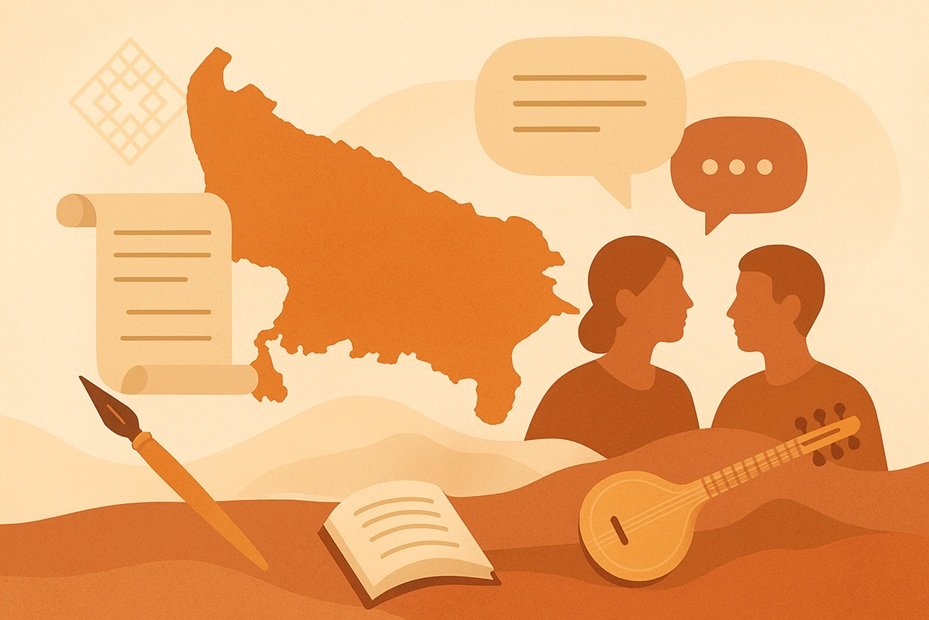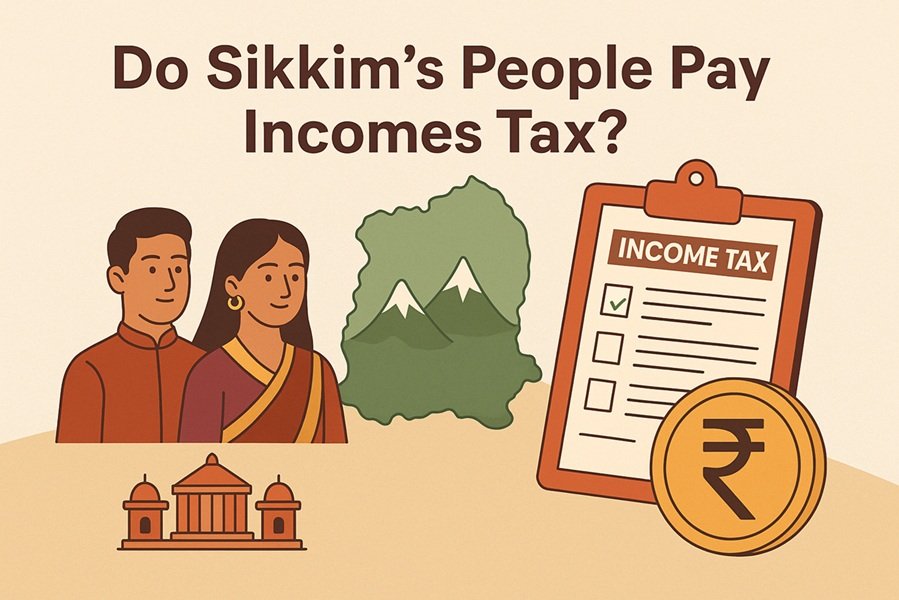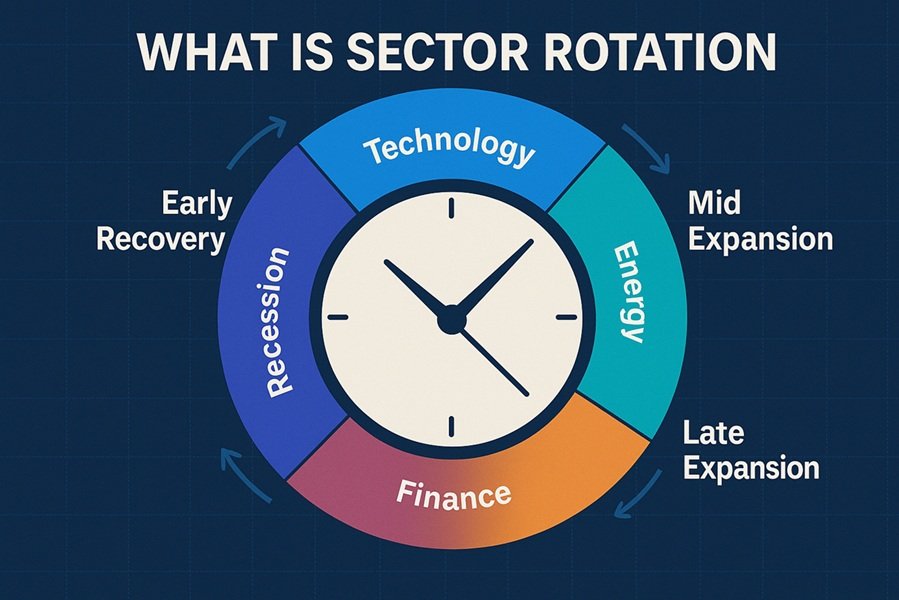
Uttar Pradesh (UP), located in the heart of northern India, is not only the most populous state in the country but also one of the richest in terms of linguistic diversity. The cultural history of this region dates back to ancient times when Sanskrit flourished in institutions like Takshashila and Varanasi. Over centuries, UP became a melting pot of languages due to migration, trade, invasions, religious movements, and cultural exchanges.
While Hindi is the official language of Uttar Pradesh, the state is home to a spectrum of dialects and linguistic forms that vary from region to region. These dialects are not merely variations in pronunciation but represent distinct cultural identities, folklore, literature, and oral histories.
Official Language: Hindi
Hindi in Uttar Pradesh is primarily based on the Khari Boli dialect. Modern Standard Hindi has evolved from Khari Boli through continuous refinement, Sanskritization, and adaptation for education, media, administration, and literature.
Characteristics
- Strong grammar structure
- Standardized vocabulary
- Used in government, education, media, and formal communication
Influence
Hindi in UP has absorbed words from:
- Sanskrit (old literary tradition)
- Persian and Urdu (Mughal era cultural exchange)
- English (modern administration and globalization)
Urdu: The Second Official Language
Urdu holds a prestigious cultural and literary status in Uttar Pradesh. Cities like Lucknow, Aligarh, and Rampur have historically been centers of Urdu poetry, storytelling (Dastangoi), and performing arts.
Urdu Cultural Legacy in UP
- Lucknowi Tehzeeb (refined etiquette and culture)
- Schools of poetry like Ghazal and Nazm
- Literary figures such as Mir Taqi Mir, Mirza Ghalib, and Josh Malihabadi
Though built on the same grammatical structure as Hindi, Urdu’s vocabulary draws heavily from Persian and Arabic, giving it a distinct sophistication and poetic tone.
Major Regional Dialects of Uttar Pradesh
1. Awadhi
Geographic Spread:
Central and eastern UP — including districts like Ayodhya, Lucknow, Gonda, Sultanpur, Barabanki, Pratapgarh.
Cultural and Literary Importance:
Awadhi is historically significant as the language of Tulsidas’ Ramcharitmanas, one of the greatest works of Indian devotional literature.
Characteristics:
- Soft-sounding tone
- Rich folk songs and storytelling traditions
- Popular in rural and semi-urban communication
2. Bhojpuri
Geographic Spread:
Eastern UP — Gorakhpur, Ballia, Deoria, Mau, Azamgarh, Varanasi outskirts.
Bhojpuri extends beyond UP into Bihar and even overseas in countries like Mauritius, Trinidad & Tobago, Fiji, and Suriname due to historical migration.
Features:
- Direct, rhythmic and expressive
- Strong presence in folk music and cinema (Bhojpuri Film Industry)
- Deep cultural connection with agriculture and festivals
3. Braj Bhasha
Geographic Spread:
Western UP — Mathura, Agra, Aligarh, Hathras, Etah, Mainpuri.
Literary Significance:
Braj Bhasha is known as the language of Krishna devotion. Many medieval Bhakti poets, such as Surdas, composed their verses in Braj, giving it devotional depth.
Characteristics:
- Lyrical and poetic nature
- Associated with Radha-Krishna cultural traditions
- Used in classical music compositions
4. Bundeli
Geographic Spread:
Regions of southern UP bordering Madhya Pradesh — Jhansi, Banda, Chitrakoot, Hamirpur, Jalaun.
Historical Context:
Bundeli was once the court language of Bundelkhand rulers. It has inspired heroic ballads and folklore, especially stories of Rani Lakshmibai and Bundela kings.
Features:
- Mix of Hindi and regional variations
- Strong heroic tone in folk songs
5. Bagheli (Border Influence Dialect)
Spoken in Mirzapur and adjoining districts. Bagheli resembles a transitional dialect between Awadhi and Bundeli and is culturally tied to tribal and rural communities.
6. Kannauji
Geographic Spread:
Areas around Kanpur, Etawah, Farrukhabad, Auraiya.
Kannauji exists in two forms:
- Western Kannauji (closer to Braj Bhasha)
- Eastern Kannauji (closer to Awadhi)
This makes it a linguistic bridge between cultures.
Linguistic Diversity and Social Identity
Language in Uttar Pradesh is often linked with:
- Rural vs. urban identity
- Cultural practices and traditional music
- Folklore, theatre (like Nautanki), and oral storytelling
- Religious poetry and historical literature
The dialect one speaks reveals regional belonging, community history, and cultural expression more than formal education or class.
Modern Influence and Transformation
With globalization, urbanization, and the rise of digital media:
- Urban youth increasingly use Khari Boli–based colloquial Hindi
- Urdu influence persists in poetry, Bollywood dialogues, and Mushairas
- Bhojpuri and Awadhi folk music are trending on YouTube and social platforms
- Braj and Bundeli remain strong in devotional and folk traditions
Despite change, dialects continue to survive because they are rooted in emotion, identity, and community memory.
Conclusion
Uttar Pradesh is not just the land of Hindi; it is a linguistic mosaic shaped by history, culture, religion, poetry, migration, and oral tradition. Its dialects — Awadhi, Bhojpuri, Braj Bhasha, Bundeli, Kannauji, Bagheli, and others — form the living soul of its people. These languages are not fading; they are evolving, adapting to time, and carrying forward the heritage of one of India’s most culturally rich regions.






